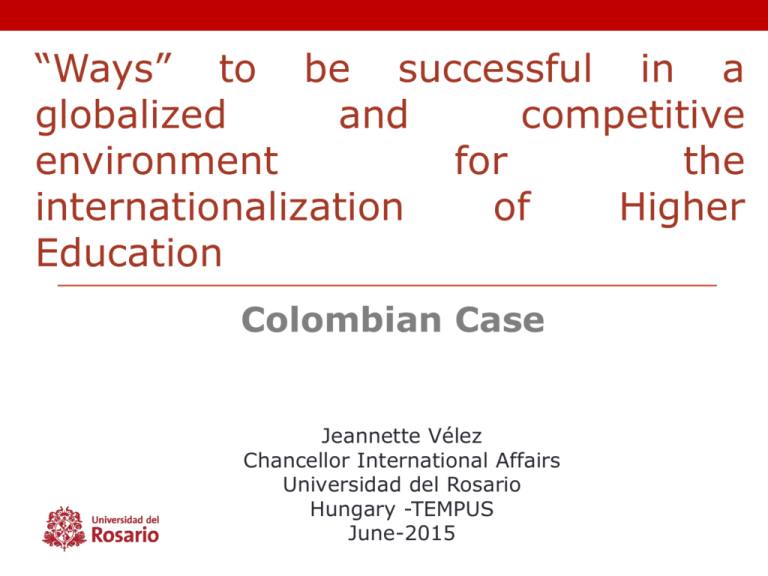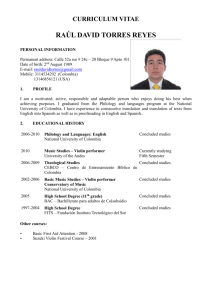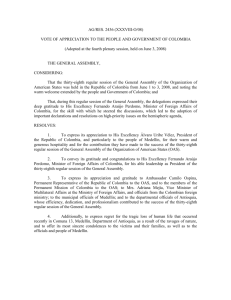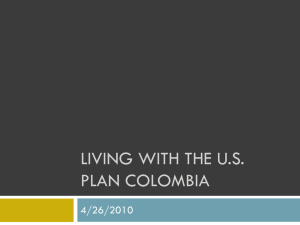Colombia
advertisement

“Ways” to be successful in a globalized and competitive environment for the internationalization of Higher Education Colombian Case Jeannette Vélez Chancellor International Affairs Universidad del Rosario Hungary -TEMPUS June-2015 AGENDA 1. Actual situation of the internationalization of HE in Colombia trends and challenges 2. Build and compete at the same timeCoopetition -CCYK -Pacific Alliance 1. Main drivers for internationalising higher education _______________________________________________________________ Outgoing mobility and opportunities for students and faculty INCLUSION Equity Internationali sation of the curriculum ……….. International research collaboration and international agreements HUMAN RESOURCES Source: Internationalization of Higher Education Growing expectation, fundamental values – IAU 4th Global Survey 2014 Eva Egron Polak and Ross Hudson & CCYKMEN 2013. Study on the Internationalization of Higher Education in Colombia and Modernization of Internationalization Indicators National System of Higher Education (SNIES) Major obstacles to making it happen _______________________________________________________________ Source: Internationalization of Higher Education Growing expectation, fundamental values – IAU 4th Global Survey 2014 Eva Egron Polak and Ross Hudson & CCYK-MEN 2013. Study on the Internationalization of Higher Education in Colombia and Modernization of Internationalization Indicators National System of Higher Education (SNIES) Trends and Challenges ________________________________________________________________ Internationalisation policy – strategies unification-coordination of all the stakeholders Human factor: Increase and training faculty / staff in the coordination and development of internationalisation processes Strengthening common regional areas of education Generating conditions for internationalisation of higher education – Mutual recognition agreements, legal framework Development new teaching methodologies - virtual education ICTs Promoting Colombia as a destination for higher education and Spanish Source: COUNTRY REPORT FOR COLOMBIA in “Internationalization of Higher Education”; European Parliament, Centre for Higher Education Internationalization at Cattolica University in cooperation with IUA & EAI, Kelly Henao & Jeannette Velez 2014. Ministerio de Educación Nacional Colombia – MEN & Observatorio de internacionalización de la educación superior – Universidad del Rosario Trends and Challenges ________________________________________________________________ Strengthen capacities of the stakeholders and the HEI Implementation of a language policy Creation of an agency that promotes the international education and the research Generating conditions for internationalisation of higher education financial, infrastructure the candy WAKING ALL TOGETHER !!! Source: COUNTRY REPORT FOR COLOMBIA in “Internationalization of Higher Education”; European Parliament, Centre for Higher Education Internationalization at Cattolica University in cooperation with IUA & EAI, Kelly Henao & Jeannette Velez 2014. Ministerio de Educación Nacional Colombia – MEN & Observatorio de internacionalización de la educación superior – Universidad del Rosario 2.1 CCYK To present our best practice (initiative born in HEI’s) + transformatives alliances. How did we promote quality Higher Education in Colombia How did we become a Network Colombia - Challenge Knowledge® -CCYK Your is a network of 20 Colombian Accredited Universities to promote COLOMBIA as a destination for academic and scientific collaboration. To promote COLOMBIAN research, academic programs and initiative Objecti ves To strengthen academic internationalization of CCYK members To study current trends in internationalization of Higher Education CCYK promotes active collaboration between Colombian Universities with worldwide HEI´s: Serves as a platform for strategic networking Shares the information about projects and initiatives Brazil B r a z i l CCYK Figures 330,000 students 29,000 academics 5,000 academics with PhD 2,200 research groups Impact on the Higher Education of the country National study about Internationalization of Higher Education in Colombia. Publication of reflexions to support the internationalization process. Accompanying program to universities in quality accreditation Special program to promote process. the Spanish by regions. Impact on education and culture within the country - Colombia • Synchronization of national agendas • Migration policy • Education brand • Spanish in Colombia • Bilingualism Policy Colombia as an international campus Quality assurance system in higher education: international partnership and international accreditation Academics Researchers (U$ 200 MM Colciencias) Students (6.000 scholarships from 2015 to 2018) RESEARCH Today topics with fundraising priority: Peace and post-conflict processes Food security Climate change Biodiversity management Sustainable and social development Medicine – tropical disease Agriculture – agroindustry SUPPORT OPPORTUNITIES – companies COLCIENCIAS •Lines •Regional strategies •Rounds BANCOLDEX Revolution of research in product innovation ICETEX OTRAS INSTITUCIONES Embassies, Colfuturo PLANEACIÓN NACIONAL •Contracts •Thematic Planning Good practice The CCYK Initiative has had an impact on members: the institutions improved their performance indicators as a result of the campaign; Number of Students, double degree agreements etc.. Global impact: improving quality and visibility of Colombia. Association of actors on the Development of basis of identification and products and services work together - work alone is - Sustainability impossible (MEN Icetex Pro Colombia, Chancery, Caro y Cuervo) Consolidation and transformation into a country Project new goals for campaign, formalization, budget, organizational the future structure - Shared responsibility Common problems to solve: Colombia unseen internationally, international ignorance of Colombian education system, low mobility to Colombia, its quality and its research potential, 2.2 PACIFIC ALLIANCE Colombian education perspective What is the Pacific Alliance? Mechanism of regional, economic and trade integration. Between Chile, Colombia, Mexico and Peru. Established on June 6th, 2012 in a memorandum of understanding In order to create markets between its members, for increased competitiveness. Source: http://alianzapacifico.net/ Objectives To build in a participative and agreeable way an area of deep integration to move progressively towards the free movement of goods, services, capital and people. To promote growth, development and competitiveness of the economies of the parties, with a view to achieve greater wellbeing, overcome socioeconomic inequality and foster social inclusion of its inhabitants. Become a platform of joint political, economic and commercial integration, and projection to the world, with emphasis on the Asia-Pacific region. Source: http://alianzapacifico.net/ Strengths The Pacific Alliance is the eighth-largest economy and the eighth largest exporter worldwide. In Latin America and the Caribbean, the block represents 37% of GDP, concentrated 50% of total trade, attracting 45% of foreign direct investment. The four countries account for a population of 214 million people and have an average GDP per capita $ 10,000. The population is mostly young and is a skilled labor force and attractive market with steadily growing purchasing power. Source: http://alianzapacifico.net/ Members maintain a network of trade agreements among themselves and with the most developed economies in the world Promotes trade, investment, innovation and technology with the most competitive regions in the world It has the potential to attract new investment to the region. FREE TRADE AREA Source: http://alianzapacifico.net/ The Pacific Alliance has competitive advantages in areas such as mining, forestry, energy, agriculture, automotive, fishing and manufacturing. Cooperation opportunities, paper of the Universities Free movement of people Cultural Promotion Improving the competitiveness and innovation of the Micro, Small and Medium Enterprises Creating a network of scientific research on climate change Integration of securities markets Tourism Preservation and environmental friendliness Opening of sales offices and joint participation in fairs and exhibitions in a single space Strengthening Relationships between Chile – Peru - MexicoColombia Source: http://alianzapacifico.net/ Education in the Pacific Alliance Best universities according to Shanghai Ranking Australia 21/500 Canada 20/500 China 32/500 Japan 19/500 Korea 10/500 Singapore 2/500 Chile 2/500 Peru 0/500 Mexico 2/500 Colombia 0/500 Source: Observatorio de Internacionalización de la Educación Superior – Universidad del Rosario Best universities according to QS. Ranking Australia 30/500 China 24/500 Japan 16/500 Canada 20/500 Korea 13/500 Singapore 2/500 Colombia 3/500 Chile 3/500 Mexico 2/500 Peru 0/500 Source: Observatorio de Internacionalización de la Educación Superior – Universidad del Rosario Chile Colombia Undergradute Duration: 5 year Tittle: Professional Undergraduate Postgraduate Postgraduate Duration Specialization: Duration: 1year PhD or Master´s: Doctorate : 2 years 5 Years Duration: 5-7 years Tittle: Graduate Mexico Tittle: Graduate “Licenciado” Duration Specialization: 1 year Duration Master´s: 2 – 3 years Posgraduate Duration PhD or Docorate: 3 – 5 years Peru Undergraduate Undergraduate Duration: 4,5,6 years Postgraduate Postgradute Duration: 5 year Postgraduate Duration Specialization: 1 year Duration PhD or Docorate: Duration Master´s: 2 years 3 years Tittle: Graduate Postgraduate Postgraduate Duration Specialization: Duration PhD or Docorate: 1 year Duration Master´s: 2 years 3 – 5 years TECHNICAL COOPERATION GROUP • Three projects have been approved and launched under the cooperation of the Pacific Alliance: 1. Platform of Student Mobility and Academic of the Pacific Alliance 2. Scientific Research Network on Climate Change 3. Synergy between the countries of the Pacific Alliance to improve the competitiveness of micro, small and medium enterprises. Source: http://alianzapacifico.net/ Platform of Student and Scholar Mobility of the Pacific Alliance Scholarships by country Mexico Chile Peru TOTAL fellows 2013 Call 3 (2014-1) Call 4 (2014 2) TOTAL fellows 2014 Total by type Undergraduate 31 35 66 44 40 84 150 Doctorate/Research/St aff Movility 1 9 10 6 10 16 26 Undergraduate 30 46 76 56 0 56 132 Doctorate/Research/St aff Movility Undergraduate Colombia Call 1 Call 2 (2013-1) (2013-2) 176 157 6 5 11 14 0 14 25 15 34 49 19 68 87 136 Doctorate/Research/St aff Movility 1 3 4 3 7 10 14 Undergraduate 9 26 35 41 53 94 129 Doctorate/Research/St aff Movility 0 3 3 2 4 6 9 93 161 254 185 182 367 CALLS TOTAL GENERAL TOTAL (Calls 1, 2, 3 y 4) Source: http://alianzapacifico.net/ Tota l by cou ntry 621 150 138 621 It is the institution responsible for the procedures for awarding grants of Pacific Alliance in Colombia. It is the institution responsible for the procedures for awarding scholarships pf Pacific Alliance in Chile. It is the institution responsible for the procedures for awarding scholarships pf Pacific Alliance in Mexico. It is the institution responsible for the procedures for awarding grants of Pacific Alliance in Peru. Areas – Pacific Alliance Scholarships • • • • • • • • • • • • • • • • Business. Finance. International trade International relations Public administration Political science Business administration Science and technology Engineering Exact sciences Economy Environment Climate change Social and human sciences Science and technology Tourism • Other areas related to cooperation projects carried out in the framework of the Group technical of cooperation GTC (gastronomy, sports and culture), as well as others relating to innovation, science and technology that conform to the objectives of the Pacific Alliance linked to commercial or international relations. Source: Amexcid, ICETEX, AGCI, PRONABEC Synergy between the countries of the Pacific Alliance to improve the competitiveness of small and medium size enterprises • It is aimed at institutional strengthening and management to improve competitiveness and innovation between Chile, Colombia, Mexico and Peru, through an exchange of knowledge and experiences in four workshops in the areas of: business competitiveness, business development, monitoring and impact assessment of programs and projects within small and medium size enterprises. Source: http://alianzapacifico.net/ New agreement Innovation, Science and Technology Environment and climate change Micro, Small and Medium Enterprises Cooperatio n Fund of the Pacific Alliance Source: http://alianzapacifico.net/ Social Development Achievements in education 1. Technical Group of Education!!! 2015 2.Countries understand the need to promote the internationalization of the future entrepreneurs of the Pacific Alliance and the need to perceive the Alliance as a single market full of opportunities. 3. Countries granted first semester of 2015l 204, undergraduate scholarships (49 for Colombians). The idea is to have professionals who know first-hand the markets of CH, MX, PE and know how to use them from Colombia. 4. Development of the network for scientific research on climate change. Source: http://alianzapacifico.net/ GTE Technical Education Group aims to strengthen the ties of educational integration through cooperation, aimed at improving the skills and capacities of the population of the member countries and their access to quality education as essential tools for the development of human capital and to boost productivity and competitiveness of the countries of the Pacific Alliance. Regional initiatives on educational cooperation • AUALCPI “Association of Universities of Latin • • • • • America and the Caribbean for Integration” IESALC “International Institute for Higher Education in Latin America and the Caribbean” RLCU “Latin American Network of University Cooperation” OUI-IOHE “Inter-American Organization for Higher Education” COLUMBUS ReLARIES “Latin American and Caribbean Network of International Relations Institutions” Source: http://alianzapacifico.net/ Pacific Canada Australia China Korea Japan Singapor e 1. 1. 1. 1. 31 Seoul National University 2. 51 KAIST - Korea Advanced Institute of Science & Technology 3. 86 Pohang University of Science And Technology (POSTECH) 4. 106 Yonsei University 5. 116 Korea University 6. 140 Sungkyunkwan University 7. 219 Hanyang University 8. 275 Kyung Hee University 9. 355 Ewha Womans University 10. 384 Sogang University 11. 431-440 Pusan National University 12. 441-450 ChungAng University(CAU) 13. 481-490 Hankuk (Korea) University of Foreign Studies 1. 1. 2. 3. 4. 5. 6. 7. 8. 9. 10. 11. 12. 13. 14. 15. 16. 17. 18. 19. 20. 20 University of Toronto 21 McGill University 43 University of British Columbia 83 Université de Montréal 84 University of Alberta 113 McMaster University 169 University of Waterloo 171 University of Calgary 187 Queen's University, Ontario 191 Western University 218 University of Ottawa 222 Simon Fraser University 235 Dalhousie University 290 University of Victoria 298 Laval University 421-430 York University 431-440University of Guelph 441-450 Université de Sherbrooke 461-470 Concordia University 481-490 University of Saskatchewan 2. 3. 4. 5. 6. 7. 8. 9. 10. 11. 12. 13. 14. 15. 16. 17. 18. 19. 20. 21. 22. 23. 24. 25. 26. 27. 28. 25 The Australian National University 33 The University of Melbourne 37 The University of Sydney 43 The University of Queensland 48 The University of New South Wales 70 Monash University 89 The University of Western Australia 92 The University of Auckland 100 The University of Adelaide 159 University of Otago 242 University of Canterbury 254 Macquarie University 257 The University of Newcastle, Australia (UoN) 264 University of Technology, Sydney 275 Victoria University of Wellington 283 University of Wollongong 285 QUT 304 Royal Melbourne Institute of Technology 324 Griffith University 331 Curtin University 333 University of South Australia 346 Massey University 350James Cook University 360 Deakin University 401-410 La Trobe University 401-410 University of Tasmania 401-410 University of Waikato 411-420 Lincoln University 2. 3. 4. 5. 6. 7. 8. 9. 10. 11. 12. 13. 14. 15. 16. 17. 18. 19. 20. 21. 22. 23. 24. 28 The University of Hong Kong 40 The Hong Kong University of Science and Technology 46 The Chinese University of Hong Kong 47 Tsinghua University 57 Peking University 71 Fudan University 104 Shanghai Jiao Tong University 108 City University of Hong Kong 144 Zhejiang University 147 University of Science and Technology of China 162 Nanjing University 162 The Hong Kong Polytechnic University 240 Beijing Normal University 318 Hong Kong Baptist University 321 Sun Yat-sen University 328 Nankai University 335 Wuhan University 379 Xi'an Jiaotong University 393Tongji University 441-450 Xiamen University 451-460 Beihang University (former BUAA) 461-470 Renmin (People’s) University of China 481-490 Harbin Institute of Technology 481-490 Huazhong University of Science and Technology 2. 3. 4. 5. 6. 7. 8. 9. 10. 11. 12. 13. 14. 15. 16. 31 The University of Tokyo 36 Kyoto University 55 Osaka University 68 Tokyo Institute of Technology 71 Tohoku University 103 Nagoya University 126 Kyushu University 135 Hokkaido University 197 Keio University 198 University of Tsukuba 220 Waseda University 294 Kobe University 294 TMDU 314 Hiroshima University 441-450 Tokyo Metropolitan University 491-500 Chiba University 2. 22 National University of Singapore 39 Nanyang Technolog ical University (NTU) China Japan Australia Korea 0,0 -100 *60 F–A *P 2 -5 *3 F - A *C 0 - 10 *4 P – HD 0 – 10 A–D 0– 5 • Universities • Research Institutes • specialized Agencies • Independent schools (since 2008) • Professional military institutions • Colleges and Schools of Medicine • Executive Training Schools • Universities • Colleges of Technology • Specialized training colleges • Junior colleges • School of graduate studies • UniversitiesTechnical Centers(TAFE) • Universities • Technical University • University Communication and dissemination • Professional University • University education • Industrial University Undergraduate degree and duration Higher Education 2-3 years (Racing mostly vocational-technical nature) Higher Education 4 years (bachelor) Bachelor degree 4-6 Bachelor degree 3-4 Bachelor degree 4 Graduate degree and duration Master´s degree 2-3 years Doctoral degree 3 years Master´s degree 2-3 years Doctoral degree 5 years Master's degree 1-2 years Doctoral degree 3-5 years Master´s Degree 2-3 years Doctoral degree 2-3 years • 726 Universities • 87 National universities • 86 Publics Universities • 553 Private Universities • 40 Universities • 37 Publics • 3 Private • 411 Universities Grading Scale Types of Institutions Public and private institutions *P (Pass) * 5,5 *D *2 Pacific Alliance as an education hub? Be recognized as a center of education excellence and economic activities What is an education hub? The term education hub is being used by countries that are trying to build a critical mass of local and foreign actors—including students, education institutions, companies, knowledge industries, science and technology centers—which, thorough interaction and in some cases colocation, engage in education, training, knowledge production, and innovation initiatives. It is understood that countries have different objectives, priorities, and take different approaches to developing themselves as reputed centers for higher education excellence, expertise, and economy. Source: Higher Education Hubs – International Higher Educations- The Boston College Center for International Higher Education, Jane Knihgt Main characteristics Location: • Geographical area ( e.g , strategy of recruitment, research) Engagement: • Types of actors involvement (Local, regional, national, privet and public and international) Impact: • Improvement of social, economic and education indicators. Activities: • Crossborder activities and internationalization at home activities basadas en la definicion de prioridades de trabajo Source: Higher Education Hubs – International Higher Educations- The Boston College Center for International Higher Education How to create an education hub? Level 1 • National planing and policies Level 2 • Connections among the actors and initiatives (common economic zone, mobility strategies, partnerships and joint academic programs). Source: Higher Education Hubs – International Higher Educations- The Boston College Center for International Higher Education Jane Knight TYPES Student hub Talent or skilled workforce hub Knowledge and innovation hub Source: Higher Education Hubs – International Higher Educations- The Boston College Center for International Higher Education Jane Knight AGREEMENTS P.A. More than 10 agreements between countries of PA Liberal professions Validation and recognition of qualifications Regional Convention of Studies, Diplomas and Degrees in Higher Education in Latin America and the Caribbean Agreements A.P – Asia Pacific • • • • • • Mexico and China: Agreement of mutual recognition of certificates of studies, titles and academic degrees between the United States of Mexico and the People's Republic of China, signed in the city of Mexico the July 30th , 2010. Australia and Colombia: Memorandum of understanding between the Government of Australia and the Government of Colombia on cooperation in the field of education and training. Signed on 6th August 2002. Colombia and Korea: Facilitate collaboration among the parties to develop information and communication technologies for the Colombian education. Colombia and Japan: Agreement of technical cooperation between the Government of Japan and the Government of Colombia. Bogota, December 22nd , 1976. Colombia and China: Promote and develop scientific and technical cooperation between the two States. Cultural agreement between the Republic of Colombia and the people's Republic of China. Beijing, October 1st , 1981. Peru has agreements of reciprocity in recognition of foreign qualifications in higher education, with the following countries: Argentina, Bulgaria, Bolivia, Colombia, Costa Rica, Cuba, Chile, China, Ecuador, El Salvador, Spain, Guatemala, Honduras, Hungary, Mexico, Nicaragua, Panama, Paraguay, Romania, Uruguay, Venezuela, Holy See and Ukraine. Accreditation system Acreditation Colombia Chile Peru Mexico Accreditation Board for Engineering and Technology ABET 15 - 1 - Accreditation Council for Business Schools programs - ACBSP 7 - 2 3 CLAEP 5 3 2 4 RIACES 4 3 2 4 UDUAL 29 3 24 64 Asociación Universitaria Iberoamericana de posgrado AUIP 2 5 Association of MBAs 1 7 3 4 Association to Advance Collegiate Schools of business 1 - - - Commission on English Language Program Accreditation - CEA 1 - 2 - European Foundation for Management Development – EFMD Quality Improvement System - EQUIS 1 - - - Source: Estudio CCYK-MEN Research Areas - PA PERU Medicine Biodiversity Raw Materials Biology and Biochemistry Engineering Administration Law Environment Technology Culture and Communication Economy Source: CONCYTEC COLOMBIA Business Economy Marketing Law Psychology Energy Biomedical engineering Climate change Mineral resources Medicine Innovation Entrepreneurship Anthropology Political Sciences Source: COLCIENCIAS MEXICO Raw Materials Biochemistry and Biotechnology Studies on management and conservation of natural resources Health, education and culture Medical Biomechanics Engineering Advanced Technology Law and social sciences Applied Sciences Environment Medicine Source: CONACYT CHILE Natural Sciences Social Sciences Humanities Engineering and Technology Economy Environment Natural Resources Source: CONICYT COMMON AREAS Medicine Raw Materials Engineering Environment Natural Resources Technology Law Biomedical Economy Applied Sciences Culture Social Sciences Energy Source: Observatorio de Internacionalización de la Educación Superior – Universidad del Rosario DOUBLE DEGREES Colombia Latin America 3% 3% 9% 4% Latin America 6% 22% United States 6% 6% 50% France Spain 12% Italy Spain France Latin America 12% Asia Others 7% 60% Asia Others United States Source: Observatorio de Internacionalización de la Educación Superior – Universidad del Rosario Centers of Excellence in Research accredited by COLCIENCIAS • 1. Tuberculosis: La investigación integrada a la Salud Pública para mejorar su control CCITB • 2. Centro Nacional de Investigaciónes para laAgroindustrialización de especies vegetales aromáticas • medicinales tropicales CENIVAM • 3. Centro de Investigacion y Estudios en Biodiversidad y Recursos Genéticos CIEBREG • 4. Centro de Nuevos Materiales CENM • 5. Centro de Excelencia en Modelamiento y Simulación de Fenómenos y Procesos Complejos • • 6. Observatorio Colombiano para el Desarrollo Integral, la Convivencia Ciudadana y el Fortalecimiento Institucional en Regiones Fuertemente Afectadas por el Conflicto Armado • Centro de Investigación en Ciencias del Mar CEMARIN • In this link, the characteristics of each one: http://www.colombiaaprende.edu.co/html/investigadores/1609/fo-article-114986.pdf Opportunities and challenges • To expand relations with Asia Pacific, with the goal of exploring new markets, that increase the competitiveness of the Alliance countries.-Technological parks • To move forward on issues of regional integration in the field of education to position Pacific Alliance as a hub of education – a first step for a common education space. • Take on the opportunity to improve the education structures of our countries with high quality and inclusive programs, focusing in developing and strenghtening research capacities with impact in knowledge generation and innovation. • To deepen the Exchange and student recruitment in the countries of the Pacific, within a quality and inclusion driven approach. • Develop agreements of mutual recognition of qualifications in order to obtain a greater circulation of people sustained, very importantly, by reform measures that facilitate employability. • Generate double degrees with countries of the Asia- Pacific. • Relieve the importance of technical education in partner countries and include technical institutions as key actors for employability. • Develop broad, inclusive language training programs including Asia-Pacific languages. Source: Observatorio de Internacionalización de la Educación Superior – Universidad del Rosario Thanks!!! Jeannette Velez R. Chancellor – International Affairs Universidad del Rosario PBX. +571- 2970200 – 2123/2120 jeannette.velez@urosario.edu.co www.urosario.edu.co




